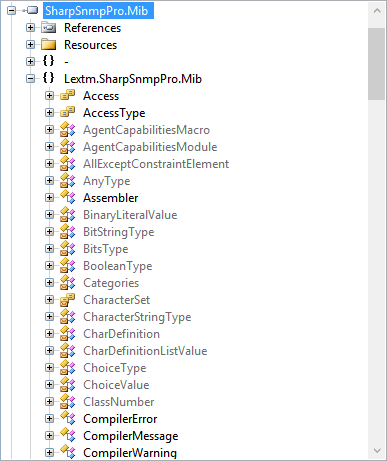SharpSnmpPro.Mib Assembly Features¶
This page provides an overview of the main features of the
SharpSnmpPro.Mib assembly.
Background¶
Our legacy product, #SNMP Suite, used to ship with an assembly called
SharpSnmpLib.Mib. However, that assembly only provided limited
functionality, and power users requested more advanced features. As a result,
we developed a new assembly called SharpSnmpPro.Mib.
The Brand New SharpSnmpPro.Mib Assembly¶
The SharpSnmpPro.Mib assembly is a key component that empowers our Compiler
Pro product.

Supported Platforms¶
Unlike the Compiler Pro, which requires .NET 4.7.1 and Windows, the
SharpSnmpPro.Mib assembly can be used on multiple platforms, including:
.NET 6 and 8
.NET Framework 4.7.1 and above
Other platforms compliant with .NET Standard 2.0.
Features¶
Let’s explore some examples that demonstrate the power of this library.
MIB Document Compilation¶
The following code demonstrates how to compile multiple MIB documents and load their metadata into memory:
var registry = new SimpleObjectRegistry();
var collector = new ErrorRegistry();
registry.Tree.Collector = collector;
registry.Import(Parser.Compile(new MemoryStream(Resources.SNMPv2_SMI),
collector));
registry.Import(Parser.Compile(new MemoryStream(Resources.SNMPv2_CONF),
collector));
registry.Import(Parser.Compile(new MemoryStream(Resources.SNMPv2_TC),
collector));
registry.Import(Parser.Compile(new MemoryStream(Resources.SNMPv2_MIB),
collector));
registry.Import(Parser.Compile(new MemoryStream(Resources.SNMPv2_TM),
collector));
registry.Refresh()
The SimpleObjectRegistry class holds the metadata in memory and can import
metadata generated via the Parser.Compile method.
The ErrorRegistry container stores errors and warnings. After calling
SimpleObjectRegistry.Refresh, you can find all errors and warnings in the
ErrorRegistry instance, helping you identify why some MIB documents cannot
be compiled or imported.
Note
The Trial version may not report all issues due to certain limitations, while the Full version does not have such limitations.
You can query SimpleObjectRegistry.Tree.PendingModules to see a list of
modules that failed to load, and SimpleObjectRegistry.Tree.LoadedModules
for a list of loaded modules.
Name/OID Translation¶
Once the metadata is extracted from MIB documents, you can use it to enable OID translation. The translation is bi-directional, allowing you to convert between names and OIDs.
const string textual = "SNMPv2-SMI::zeroDotZero";
var number = new uint[] { 0, 0 };
Assert.AreEqual(textual, registry.Translate(number));
Assert.AreEqual(number, registry.Translate(textual));
The Translate method provides a single textual form of the OID. In some
cases, a single OID can have multiple textual forms, as it might be defined in
multiple documents with different modules and names. To retrieve all the textual
forms of an OID, you can use the following code:
var number = new uint[] { 0, 0 };
var searchResult = registry.Tree.Search(number);
var definition = searchResult.Definition;
var textualForms = definition.TextualForms;
Extract Object Identifier Metadata¶
Once all the metadata is loaded in a SimpleObjectRegistry instance, you can
easily extract information for individual objects:
Definition item = registry.Tree.Find("SNMPv2-MIB", "sysDescr");
IEntity entity = item.DisplayEntity;
Assert.AreEqual("A textual description of the entity. This value should include the full name and version identification of the system's hardware type, software operating-system, and networking software.", entity.DescriptionFormatted());
Assert.AreEqual(EntityStatus.Current, entity.Status);
Assert.AreEqual(string.Empty, entity.Reference);
var obj = entity as IObjectTypeMacro;
Assert.AreEqual(Access.ReadOnly, obj.MibAccess);
Assert.AreEqual(SnmpType.OctetString, obj.BaseSyntax);
By using the SimpleObjectRegistry.Tree.Find method, you can locate a
Definition instance for a specific OID, such as SNMPv2-MIB::sysDescr
(OID: 1.3.6.1.2.1.1.1). Each Definition instance contains one or more
IEntity instances that match their entity definition in MIB documents.
From the Definition.DisplayEntity property, you can access various
properties of the entity, such as IEntity.DescriptionFormatted,
IEntity.Status, and IEntity.Reference.
If the entity is an OBJECT-TYPE macro, you can cast it to
IObjectTypeMacro to access additional properties, such as
IObjectTypeMacro.MibAccess and IObjectTypeMacro.BaseSyntax. In the case
of SNMPv2-MIB::sysDescr, the data type is OCTET STRING.
There are other properties you can review, which are documented in the API reference.
Note
The Trial version has limitations on which attributes you can see, while the Full version does not have such limitations.
Table Validation¶
With MIB documents, it is easy to determine if an OID represents a table, a table entry, or a table column.
var table = new ObjectIdentifier(new uint[] { 1, 3, 6, 1, 2, 1, 1, 9 });
var entry = new ObjectIdentifier(new uint[] { 1, 3, 6, 1, 2, 1, 1, 9, 1 });
var unknown = new ObjectIdentifier(new uint[] { 1, 3, 6, 8, 18579, 111111 });
Assert.IsTrue(registry.ValidateTable(table));
Assert.IsFalse(registry.ValidateTable(entry));
Assert.IsFalse(registry.ValidateTable(unknown));
By accessing the Children property of a table object, you can query the
entries of that table. Similarly, by accessing the Children property of an
entry object, you can query the columns of the table.
Input Data Validation¶
In SNMP managers or agents, it is common to validate whether a piece of data is valid for an OID. MIB documents define various constraints, but extracting them from the files can be challenging. With a few lines of code, you can now perform data validation:
Assert.IsTrue(registry.Verify("SNMPv2-MIB", "sysDescr", new OctetString("test")));
Assert.IsTrue(registry.Verify("SNMPv2-MIB", "sysDescr", new OctetString(string.Empty)));
Assert.IsFalse(registry.Verify("SNMPv2-MIB", "sysDescr", new Integer32(2)));
You can easily test if the data is valid for SNMPv2-MIB::sysDescr.
Note
The Trial version only supports data validation against a limited set of
default types (defined in core MIB documents), while the Full version
supports custom types such as BITS, CiscoRowOperStatus, and
CiscoPort.